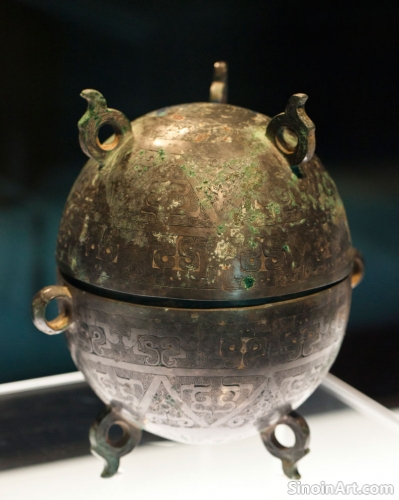Bronze Ware and the Development of Ancient Chinese Ceramics: Form and Decoration
|
While bronze ware held a unique place in ancient China, its forms, decorative styles, and technical aspects also had a notable influence on the development of Chinese ceramics. The skills and artistry developed in bronze production also greatly influenced the traditions and techniques that were used in the creation of ceramics. The interplay of these two art forms helped to shape their shared history.  Early ceramic vessels often replicated the shapes of bronze ritual objects, including the ding, gui, and zun, demonstrating the lasting impact of bronze forms on later material culture. The use of similar forms helped to suggest a continuity of tradition and a link to the prestige and power of the earlier metal work.  The techniques of decoration, including incised lines, relief patterns, and geometric motifs, were also adapted from bronze ware, with ceramic artists emulating the aesthetic principles of bronze in their own work. The motifs and designs were often carried over from one material to another. The use of similar decorative styles helped to create a sense of continuity and tradition.  The study of this cross-influence between bronze and ceramics helps us to appreciate the interconnectedness of different art forms in ancient China, as well as the creative and technical innovations that arose from the combination of different styles and materials. The interaction between the two art forms is a key element in understanding their shared history and their impact on Chinese culture. |
Tag : bronze influence ceramics, ancient pottery, Chinese art, ceramic design, shared traditions
Related information
- The Relationship Between Bronze Vessels and Food Culture in Ancient China
- Bronze Ware and the Development of Ancient Chinese Astronomy: Instruments, Charts, and Cosmological Beliefs
- The Symbolic Significance of Bronze in Ancient Chinese Power Structures: Ritual, Authority, and Legitimacy
- Bronze Vessels as Symbols of Ancestral Veneration: Connecting the Living and the Dead
- Bronze Ware and the Development of Ancient Chinese Music Theory: The Role of Tuned Instruments
This article explores the connection between bronze vessels and food culture in ancient China, highlighting their use in the preparation, presentation, and consumption of meals, and emphasizing the importance of food in both daily life and ancestral rites.
This article explores the interplay of bronze ware and ancient Chinese astronomy, highlighting the creation of observational tools, the symbolic representation of celestial bodies, and how bronze helped to express ancient beliefs about the universe.
This article explores the symbolic significance of bronze in ancient Chinese power structures, highlighting its role in ritual practices, its symbolism of authority and legitimacy, and its use by rulers to consolidate political control.
This article explores the use of bronze vessels in ancestral veneration in ancient China, highlighting their role in connecting the living and the dead, honoring family lineages, and emphasizing the core values of ancestor worship.
This article explores the influence of bronze ware on the development of ancient Chinese music theory, highlighting the role of tuned instruments, especially bianzhong bells, and their impact on scales, harmonies, and the understanding of musical structure.